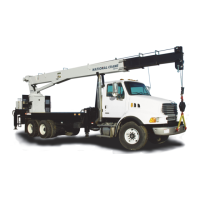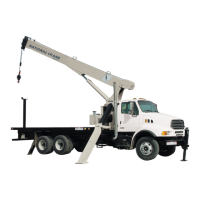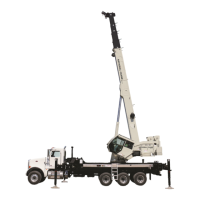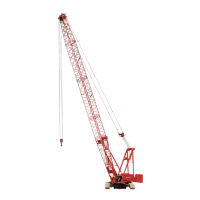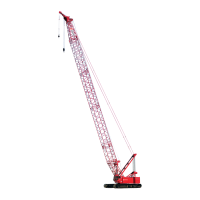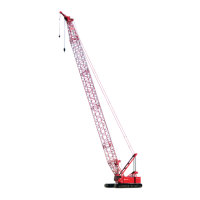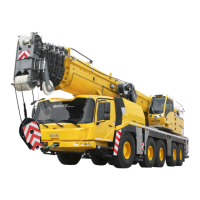INSTALLATION 1400H OPERATOR AND SERVICE MANUAL
7-30 Published 10-30-2014 Control # 040-09
STABILITY CHECK
The bare chassis weight, before the crane is mounted, is
intended for use only as a guideline in determining the total
weight required for the unit to be stable with an 85% tipping
factor (i.e. when lifting capacity load, the unit is at 85% of
tipping or less).
In order to ensure the stability of the unit with an 85%
tipping factor, a live load stability test must be performed on
each completed unit. Using the following as an example
only:
1. Test the unit for stability on a firm level surface.
2. A Series 1400H crane requires RSOD stabilizers for
stability. With the boom stowed, set the unit up level on
the outriggers and stabilizers.
3. When stability testing this unit, select the load at the
specified boom extension and radius listed in the
example below.
Stability test conditions represents overloads at
crâne positions where boom weight and CG location
make up a large portion of the overturning moment.
Great care should be taken to control boom position
and keep hook load close to the ground. Test loads
should not be allowed to swing out past rated
radius. If overturning caused by the load is allowed
to start, and boom angle gets too low, boom weight
may cause the unit to upset.
The stability test load will be 1.18 times the load chosen
from the load rating area of the capacity chart.
Example 1: 14100H without 54 ft Jib Stowed
Boom Length: 100 ft (30,5 m)
Loaded Radius: 85 ft (25,9 m)
Test Load for Stability with no Jib Stowed:
*1050 lb (476 kg) + 250 lb (113 kg) =
1300 lb (590 kg)
Stability Test Load: 1.176 x 1300 lb (590 kg) =
1529 lb (694 kg)
(Includes weights of slings and downhaul blocks.)
* Note: The 1050 Ib (476 kg) capacity from the load
ratings area of the capacity chart is for the 14100H with a
54 ft jib stowed on the side of the first section boom. From
the “ADD TO CAPACITIES WHEN NO JIB STOWED” area
under the load ratings chart 250 Ib (113 kg) is added to the
1050 Ib (476 kg) rated load.
Example 2: 14127H with 31 ft Jib Stowed
Boom Length: 51 ft (15,5 m)
Loaded Radius: 40 ft (12,2 m)
Load Rating with Jib Stowed:
*8100 lb (3674 kg)
Add to Rated Load for Stability Test when Jib Stowed:
217 lb (98 kg)
Total Load for Stability Test:
8100 lb (3674 kg) + 217 lb (98 kg) =
8317 lb (3772 kg)
Stability Test Load with 311 ft Jib Stowed:
1.176 x 8317 lb (3772 kg) =
9781 lb (4437 kg)
(Includes weights of slings and downhaul blocks.)
* Note: Capacity from the load ratings area of the
capacity chart.
Be sure the stability test weight is accurate. A 1 %
increase in stability test weight will mean up to a 10%
increase in counterweight. Extend the boom to the
specified boom length and hoist the stability load off the
ground. Slowly boom the load down so the load will
swing out, until the loaded radius is reached. As the
boom is lowered keep hoisting the load up to keep it
about 6 in off the ground.
Do not exceed loaded radius.
Slowly rotate the boom throughout the work area. As the
boom is rotated, the boom will have to be raised and/or
lowered to maintain the loaded radius because of
subbase flexure.
On units not equipped with front stabilizers, tipping from
stabilizer support to front wheel support will occur as the
load or boom is swung around the front. Do not attempt
Model Boom Length
Loaded
Radius
Add to Rated
Load When Jib
Stowed
14127H
14100H
1469H
127 ft (38,7 m)
51 ft (15,5 m)
100 ft (30,5 m)
44 ft (13,4 m)
69 ft (21 m)
34 ft (10.4 m)
90 ft (27,4 m)
40 ft (12,2 m)
85 ft (25,9 m)
40 ft (12,2 m)
65 ft (19.8 m)
30 ft (9.1 m)
83 lb (37,6 kg)
217 lb (98,4 kg)
201 lb (91,2 kg)
430 lb (195,0 kg)
N/A
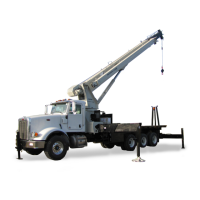
